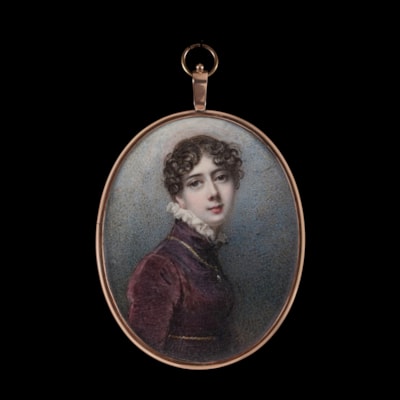JOHANN BAPTISTE GOESTL (GÖSTL)
(1813-1895)Portrait miniature of the Artist's Son wearing Turkish costume
Watercolour on ivory
Ivory registration number: DRCM96J3
Gold-plated metal frame
SOLD
A small circular head and shoulders copy of Ross’s portrait, of a similar size and composition to the present work, was made by Victoria’s enamel painter, William Essex (1784-1869) and given by the queen to her husband on their wedding anniversary in 1851 [fig. 2]. It’s not unreasonable to speculate that Goestl also made a gift of the present portrait to his wife, which, being so small, could have been neatly set in a piece of jewellery.
While there is no record for the source of the either the princess’s or the present sitter’s costumes, they reflect the fashionable interest in the arts and dress of the East at this time. The Orient (including present-day Turkey, Greece, the Middle East, and North Africa) had long tantalised western artists. Following a series of conquests and military campaigns in the region, it became more accessible and a popular setting for European history and genre painting with many European artists travelling to the Near East. The decorative arts, textiles, furniture, architectural motifs and fashion were soon to follow suit and Orientalism swept the continent.
Goestl is said to have worked in the porcelain factory in his home city of Vienna, where he painted ceramic placques.[2] He is recorded by Leo Schidlof as initially training at military school however, and only coming to painting after working for a short time as a bank clerk.[3] He later became a pupil of Ferdinand Georg Waldmüller (1793-1865), one of the most significant Austrian artists of the age.
[1] Art Journal, 1851, new series, vol. III, p. 161
[2] Duffy, S., Vogtherr, C. M., Miniatures in The Wallace Collection, 2010, p.164
[3] Schidlof, L., p.300
Dr. Erika Pohl-Ströher;
Sotheby's, Geneva, 6 May 1981, lot 182.

shipping notice
Worldwide shipping is included in all prices.
The Limner Company does not accept any responsibility for import duty, this is to be paid by the buyer.
Some stock items contain materials from endangered species which are governed by CITES regulations and will require a permit to export outside of Great Britain. If a certificate of export is required then this will be the responsibility of and paid for by the buyer .
you may also like















